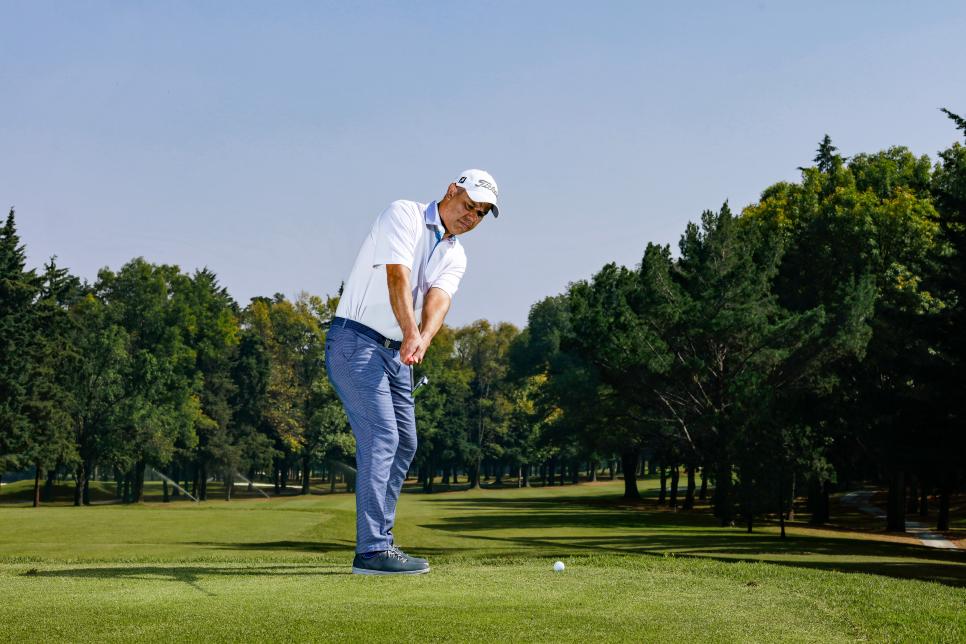Instruction from some of Golf Digest's Best International Teachers

Dom Furore
They might speak it in different languages, but the message is universal: Better golf is just a lesson away. In conjunction with Golf Digest’s first list of the Best International Teachers, which identified 75 instructors in 33 countries, we asked three of the top coaches outside the United States for their advice on game improvement. Here are their thoughts on topics ranging from driving to bunker play.
GET STARTED LIKE A PRO
TWO EASY WAYS TO MAKE YOUR SWING REPEATABLE
BY HORACIO MORALES • MEXICO

It stands to reason that if you can get your swing off to a good start, you’ll greatly improve your chance of hitting a quality shot. want to give you two easy ways to do it. Let’s start with your setup. Instead of addressing the ball with your feet perpendicular to the target line, flare them a little. Why? It improves your body’s ability to rotate back and through during the swing and helps prevent a common problem that is a big reason amateurs struggle to make good contact with the ball—swaying. You don’t have to be exact, but I recommend opening the trail foot by 20 to 25 degrees and the lead foot a little more than that. You’ll find you can turn much better on both sides of the ball without swaying out of position. It’s great for consistency.

My other tip involves the first few feet of your backswing. Another common mistake is fanning the clubface open in the takeaway. It happens when the club is being controlled by the arms and not the shoulders. Your torso should get the swing started. When the takeaway is shoulder-driven, the clubface stays square to your path, which puts you in much better position to hit an accurate shot. You can verify that the clubface is square by looking back at it when the shaft is roughly parallel to the ground in the backswing. At that point, the clubface should be pointing down toward the ball. Like I said, if you can set up to the ball and take the club back a little better, you’re on your way to consistently good golf shots.
HORACIO MORALES is director of instruction at Chapultepec Golf Club near Mexico City. He teaches Gaby Lopez on the LPGA Tour.
REV UP YOUR SWING SPEED
A TOWEL CAN TEACH YOU TO POWER THROUGH IMPACT
BY PAUL DYER • GERMANY

Dom Furore
Sometimes the simplest things can be used to make your golf swing better. That’s certainly true of a standard bath towel, which has a lot of uses as a teaching tool. One of my favorites is using it to train good sequencing in the swing. Many amateurs struggle with the concept of completing the backswing and then starting down with gradual acceleration that puts the fastest part of the swing where it should be—through the impact zone. Instead, they rush through the backswing and the start of the downswing and get out of sync. Let me show you how a towel can correct that.
Roll up a bath towel and grab it at one end with your hands slightly apart, or you can use your golf grip if you like. Next, mimic a backswing as if you were holding a club, and wind up until the towel drapes across your back. When you feel the towel splay, that’s your cue to start the downswing.

Dom Furore
The goal is to get the towel to make a snapping sound around the point where your club would make contact with the ball. To do that, you have to press down hard into the ground with your front foot. As your body unwinds in the direction the towel is moving, you’ll notice that to make the towel snap, your left leg has to straighten and your hips have to stop rotating. That lets your arms and the towel release toward the target . It’s a quick and powerful move. Repeat this drill several times, and you’ll get a good feel for the sequence of body, arms and then club when you swing.
PAUL DYER is a master certified instructor for the Leadbetter Golf Academy in Velbert, Germany. He has been teaching for more than 25 years.
THUMP THE SAND
A DRILL TO MAKE BUNKER PLAY EASIER
BY SIWOO LEE • SOUTH KOREA

The best thing about hitting shots in greenside bunkers is that you don’t have perfect with your contact to get a good result. If you slide the clubhead through the sand under the ball, your wedge can touch down anywhere from a few inches behind the ball to right behind it, and your shot is going to carry onto the green as long as you complete the swing. Knowing this should make you less anxious when you find your ball in a bunker.
If you’re nervous, your body and arms tend to stiffen, and you straighten up hoping to scoop the ball out with some exaggerated body action. The likely result is a mis-hit, too fat or thin. To improve your contact, think about lowering your center of gravity as you swing down. A drill I like to use to help prevent standing up on bunker shots is to hold your wedge with your trail hand while putting your lead hand on your chest (above). Now make a swing letting the club glide through the sand while the back of your lead hand faces downward through impact. Your body should remain steady as your arm swings the club. If you maintain this down-facing position with your lead hand, your center of gravity won’t change from address to impact, and you’ll thump the sand behind the ball. Don’t forget to finish the swing!
SIWOO LEE is the lead instructor at Big Fish Golf Academy in Seoul, South Korea. He teaches Jin Young Ko, who is No. 1 on the Rolex Women’s World Golf Ranking.